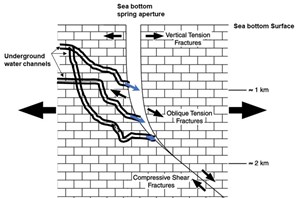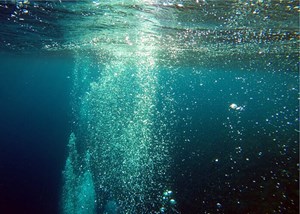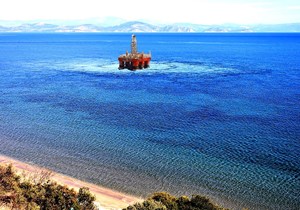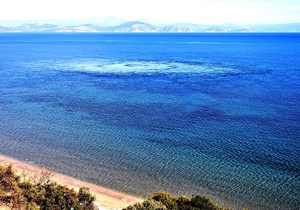Deepwater technology: Offshore drinkable water production from subsea karstic aquifers
Abstract
The main scope of this paper is to describe the possible and secure production method of huge quantities of fresh/drinkable water from subsea bottom springs, by separating this meteoric (in origin) groundwater from the saline seawater. The separation will take place in simple devices by using offshore installations and production technologies already developed in the offshore oil and gas industry.
It is an environmentally friendly and efficient new technique that can be easily implemented, since there is nothing involved that would damage the sea environment and the living ecosystem in near-shore operations.
This method has never been applied before in the world, and is clearly innovative.
In many places around the world, large quantities of meteoric (initially drinkable) water are directed through rivers to oceans or various geological formations, changing its chemical properties as a result, making it inappropriate for covering necessary human primary (i.e. drinking or irrigation) requirements. The demand is growing bigger, especially when combined with climate effects and overpopulation.
In this specific case, the exploitation of the water carried by underground channels (subsurface rivers)—located far from any human activity and therefore avoiding getting close to any pollutant source—leads to sea bottom springs. This source of offshore clean groundwater will be accessible by using petroleum technologies to securely promote its utilization.
Furthermore, by expanding this project’s application, huge quantities of fresh water can be saved and produced worldwide, instead of ending up in the sea and the oceans.
The continuous, uninterrupted flow and "endless" duration of the project is due more to the complicated karst system—created by the erosion of centuries in the inner structure of the mountain—and less to complicated geological formation tectonics, thus contributing to the "installation of an ideal hydraulic system", through which huge amounts of water are fed through "drains" to the bottom of the sea.

In this specific case, as a natural phenomenon, large quantities of water continuously flow underground1, ending up at the sea bottom in a place (Fig.1) located near Athens, Greece, Fig. 2.
This physical phenomenon, which has gone on for thousands of years—as per historic evidence—is located at a depth of 179 meters in the form of subsea spring (clean meteoric/drinkable water), with very high flow rates. Its source is a huge area, which consists of several (high altitude) mountains located in the wider region, that is rich due to an extensive system of groundwater aquifers, providing millions of cubic meters of clean water yearly. These huge quantities2, in most cases, are mixed with sea water, resulting in a slightly lower density of saline water.
In this case, the fresh water originates from a karstic system3 of tubes at the bottom of the sea near shore at a very high pressure, caused by artesian flows, and comes up to the sea surface like a well-organized very tall and thick water column (Fig.3), which flickers because of buoyant forces4 towards the sea surface, Fig. 2.

Therefore, for this specific case, instead of offshore oil production, an attempt will be made on production of offshore drinkable water from its original aquifer, avoiding any mixture with saline water.
It is well known that the petroleum industry has achieved great milestones in the areas of offshore exploration and exploitation. On the other hand, global water demand is drastically rising, and thus, technology and innovation are two of the pillars that will transform the petroleum industry of the deepest subsea oil and gas developments into water production experts, by properly designing offshore infrastructures for producing huge quantities of drinkable water. This strength certainly contributes strongly to the fulfillment of our vision to meet the world's inaccessible up-to-date water resources management challenges5, Fig 4.

Project objectives
According to up-to-date drinkable water standards, we propose a very efficient solution, which—through an innovative technique that is suggested to be implemented—will add great value to the clean, potable water worldwide.
The term "water scarcity" involves the different water availability states, that is, stress, shortage and crisis. The term "water crisis" is a situation where the available potable, unpolluted water within a region is less than that region's demand. According to recent research11, it has been proven that by 2025, 1.9 billion people will be living in countries or regions with absolute water scarcity, and two-thirds of the world’s population could be under stress conditions.
This proposal includes the design and creation of a mechanism capable of securely diverting (i.e., avoiding mixing with the sea water) the amount of water into storage tanks and finally transporting it to the consumers for direct use. The water's composition has already been tested and identified as clean and potable.
The petroleum industry—which mainly is a method of subsea exploitation—has achieved great milestones and its adventure is far from over. Global water demand is drastically rising, and innovation and technology are two of the pillars that have allowed us in the petroleum industry to become experts in environments, from the deepest subsea oil and gas developments to the largest and most complex offshore infrastructures.
Our team has studied this specific case in depth and concluded that, from this unique and easily accessed site, it is possible to produce large quantities of drinkable water. We all know that due to the increase of the earth’s population and the pollution of groundwater aquifers, the drinkable water available gets more and more expensive. A source like the one described would be very helpful for various sized municipalities, and our scope is to exploit this kind of resource to make it accessible to societies.
Methodology
Before any decision is made for this type of project’s initiation phase, seismic and other types of geophysical profiles—such as mapping the seabed with underwater video/photogrammetry—must be acquired of a very restricted area and depth on the site, in order to detect the subsurface water channel6,7, taking the clean/meteoric (and certainly not polluted) water to the sea bottom, where the spring is located. These results will affect the decision for the shallow offshore drilling characteristics.
Our experience with subsea technologies, which has been applied by the oil and gas industry all over the world, leads us to the decision that the use of such a production device would be technologically easy to develop, with insignificant risk.
The best way to separate the drinkable water from the sea water is by properly constructing a bottom sea infrastructure of the appropriate diameter. This special geometric casing, once carefully positioned on the seabed, will have the ability to achieve two specific objectives.
The first one will be to provide isolation of the meteoric water from the saline environment, while the second is to divert the flow of the fresh water outside the seabed environment securely, through pipes to an outer structure for further storage, in order to be available for smaller containers (i.e., bottling, etc.). As an upstream water flow has been created into the casing, and given that the water column—due to very high production rates (Fig. 2, 3) and artesian flow—comes up at high pressures, it follows that the fluid carries within it very high kinetic energy, which in turn can be used to avoid spending huge amounts of electrical energy in pumping the water towards the surface, for further processing or usage.
The level of success of this project is very high, as there are many advantages to the area where the site is located. This is also the main reason for why this project can be attractive to investors and stakeholders.
At the moment, a number of important elements in the project have been decided, and specific data have been collected, such as chemical analyses of the water, pressure variations during the year, area selection for the construction of the producing device, stabilization of the wet ground, artesian pressure management, recirculation systems, pumping testing, groundwater recharge, surrounding geological formations7,8,9,10, permitting and stakeholder negotiations, etc. It is worth noticing that the sea surface, where the water comes out, is only 150 meters from the coast, which is also very close—only a few tens of meters from the local motorway. This solves a number of transportation issues emerging at several stages of the project development.
Similar cases to the one proposed can be found in many other areas within Greece and/or worldwide. Throughout this project, it is our aim to obtain a high level of experience on the development of these systems around the globe, in order to produce huge quantities of fresh water for societies, by using the lowest possible amount of energy with an innovative and sustainable method.
Conclusion
Worldwide, domestic water use accounts for about 1/5 of water withdrawals. Many societies have always treated water as an inexhaustible resource. However, there are many places in the world that are obliged to cover their water needs by buying large quantities of water (sometimes at very expensive rates). Water demand problems exist even in areas where the natural cleansing and renewing functions of the hydrology cycle do not work properly, due to system’s overload or damage (renewal of water certainly takes time). The primary aim of this project is to use a submersible water discharge system, in order to produce fresh/potable water for covering domestic needs. The water would be extracted and transferred to a (low energy consumption) water bottling plant, which is going to be built either onshore or offshore.
Water is a very important commodity. Statistical trends show that its demand (and therefore, value) will increase rapidly in the following years, due mainly to overpopulation and contamination, and therefore, this is the main reason that makes this project and achieving the aforementioned goals a great necessity for the good of humanity.
About the authors
Dr. Marios Patsoules studied philosophy and petroleum geology at the University of Sheffield, where he earned a PhD in 1982. He spent his post-doctoral at the Norwegian University of Science and Technology (NTNU), and he began working for Hellenic Petroleum Co. as Head of Labs, Reservoir Geology and Engineering, as well as taking on roles in public and international affairs. He has also worked in a variety of collaborative roles with companies including GEUS, Statoil, IKU, Enterprise Oil, Phillips Petroleum, Norsk Hydro, Saga Petroleum, Repsol, Woodside, Schlumberger, Corelab, and USGS. He has founded two energy institutes based in Greece—The Institute of Energy for Southeast Europe and the European Energy and Technology Institute—and has published over 300 publications including papers, books, reports, and conference proceedings. On 1996, he successfully organized the first international concession round in Denver, Colorado, for the exploration and exploitation of Greek hydrocarbons, as the Director of International Affairs in the Public Petroleum Corporation of Greece.
Dr. George Karlatiras was born in 1978 in Athens. He studied mechanical engineering at Kings' College London from where he obtained an MSc and later, a PhD title in 2006 on fluid mechanics. He then returned to Greece in order to carry out his national service in the Hellenic Air force as an Aircraft Inspection Engineer. In 2007, he joined the Institute of Energy for South East Europe (IENE) as a scientific coordinator in Renewable Energy Systems' sector, in which he organized seminars, created research papers/publications and was involved in European projects with partners not only in the southeastern region but also in the wider area of Europe. In 2010, he continued his career in Public Power Corporation Renewables (PPCR), dealing with several RES projects around Greece. At the same time, he started giving lectures in the Merchant Marine Academy of Ministry of Mercantile Marine. He has been involved in a number of collaborating projects with Greek Organizations, Governmental Educational Institutes, Universities and the Hellenic Air Force. He has taught several Engineering courses and he has participated in a large number of seminars and conferences dealing mainly with the renewable energy systems and energy management.
References
1. Benest, H., 1899: Submarine gullies, river outlets, and fresh-water escapes beneath the sea-level. Geogr. J. 14 (4), 394–413.
2. Helene NikiGeorga, 2018: Study of the subsea water flow in the area of Anavalos, Argolis. Internal Report, University of Aegean, Dept. of Sea Science (in Greek).
3. Bögli, A., 1980: Karst Hydrology and Physical Speleology. xiii Springer-Verlag, Berlin; New York (284 p. pp).
4. Burnett W.C., Chanton J.P., Kontar E. (editors), 2003 b: Submarine groundwater discharge, vol. 66(12). Spec Issue, Biogeochemistry, 202pp.
5. Stephen Rassonfloss, JPT/JPT Online Staff Writer Augusta 2011.: Growing Offshore Water Production Pushes Search for Subsea Solutions.
6. Michael, H.A., Russoniello, C.J., Byron, L.A., 2013: Global assessment of vulnerability to sea-level rise in topography-limited and recharge-limited coastal groundwater systems. Water Resour. Res. 49 (4), 2228–2240.
7. Moosdorf N., T. Oehler Leibniz, 2000: Centre for Tropical Marine Research (ZMT), Fahrenheitstrasse 6, 28359 Bremen, Germany Societal use of fresh submarine groundwater discharge: An overlooked water resource. 8. Dr. Marios G. Patsoules (Public Petroleum Corporation of Greece), 1983A Textural Classification of Chalk Porosity, Document IDSPE-12286 MS, Publisher: Society of Petroleum Engineers.
9. Prof. Scholle Peter, Patsoules Marios, 2008: Depositional and Diagenetic Patterns in Cretaceous Carbonate Platforms, Ionian Islands, Greece. AAPG Conference, Athens Greece, Megaron.
10. Prof. Peter A. Scholle - (New Mexico Bureau of Geology), Dr. Marios G. Patsoules - (Hellenic Petroleum SA), 2008: Deposition, Diagenesis and Petroleum Potential of Cretaceous Carbonate Platforms, Ionian Islands, Greece. AAPG Conference: "Challenge the Myth", Megaron Athens, Greece.



